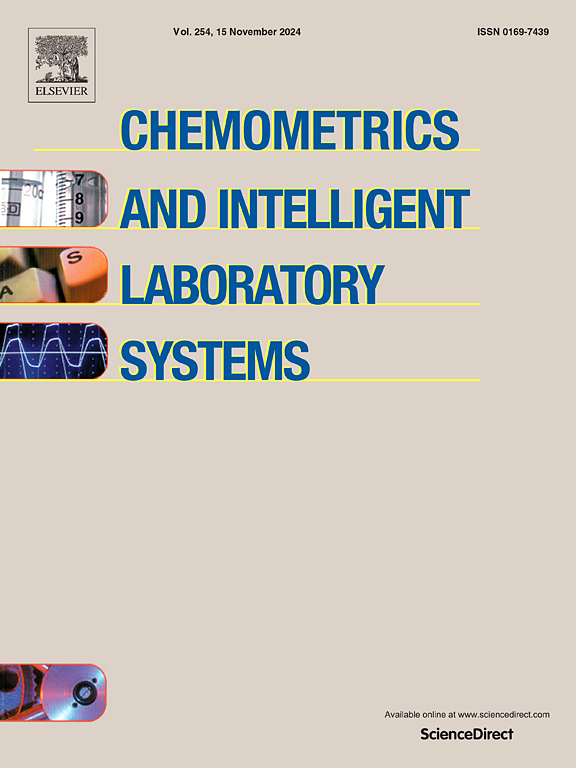Kernel-based reliability potential to assist QSPR prediction and system transfer of SFC−MS retention time
IF 3.8
2区 化学
Q2 AUTOMATION & CONTROL SYSTEMS
Chemometrics and Intelligent Laboratory Systems
Pub Date : 2025-05-08
DOI:10.1016/j.chemolab.2025.105435
引用次数: 0
Abstract
Quantitative Structure-Property Relationship (QSPR) allows in silico prediction of chromatographic retention time of chemicals from their molecular structure. The QSPR approach relies on the principle that retention time is influenced by molecular properties, which can be encoded into chemical-structural descriptors and modelled with chemometric techniques. This study focuses on in silico prediction of supercritical fluid chromatography (SFC) retention time. First, we developed a novel QSPR model for predicting retention times measured with high-resolution mass spectrometry (SFC-HRMS); then, the same model was adapted to predict retention times of a different chromatographic system based on low-resolution mass spectrometry (SFC-LRMS). We used a kernel-based approach to account for prediction uncertainties and to leverage the model reliability by defining a structural domain in the chemical space where lower uncertainty is expected. Results demonstrated that the proposed approach can predict retention time across two chromatographic systems when considering the reliability domain established with the kernel approach. The use of the proposed method for estimating the reliability domain can enhance the application of QSPR models to predict and transfer retention times in chromatographic systems similar to those used for the calibration and, consequently, simplify the identification of compounds in untargeted analyses and boost the design, development and optimization of novel chromatographic methods.
基于核的可靠性潜力,以协助QSPR预测和SFC - MS保持时间的系统转移
定量结构-性质关系(QSPR)允许从分子结构预测化学物质的色谱保留时间。QSPR方法依赖于保留时间受分子性质影响的原理,分子性质可以编码为化学结构描述符,并用化学计量学技术建模。本文主要研究了超临界流体色谱(SFC)保留时间的计算机预测。首先,我们开发了一个新的QSPR模型,用于预测高分辨率质谱(SFC-HRMS)测量的保留时间;然后,将相同的模型应用于基于低分辨率质谱(SFC-LRMS)的不同色谱系统的保留时间预测。我们使用基于核的方法来解释预测的不确定性,并通过在化学空间中定义一个结构域来利用模型的可靠性,其中预期的不确定性较低。结果表明,当考虑核方法建立的可靠性域时,该方法可以预测两种色谱系统之间的保留时间。使用所提出的方法来估计可靠性域,可以增强QSPR模型在类似于用于校准的色谱系统中预测和传递保留时间的应用,从而简化非靶向分析中化合物的鉴定,并促进新型色谱方法的设计、开发和优化。
本文章由计算机程序翻译,如有差异,请以英文原文为准。
求助全文
约1分钟内获得全文
求助全文
来源期刊
CiteScore
7.50
自引率
7.70%
发文量
169
审稿时长
3.4 months
期刊介绍:
Chemometrics and Intelligent Laboratory Systems publishes original research papers, short communications, reviews, tutorials and Original Software Publications reporting on development of novel statistical, mathematical, or computer techniques in Chemistry and related disciplines.
Chemometrics is the chemical discipline that uses mathematical and statistical methods to design or select optimal procedures and experiments, and to provide maximum chemical information by analysing chemical data.
The journal deals with the following topics:
1) Development of new statistical, mathematical and chemometrical methods for Chemistry and related fields (Environmental Chemistry, Biochemistry, Toxicology, System Biology, -Omics, etc.)
2) Novel applications of chemometrics to all branches of Chemistry and related fields (typical domains of interest are: process data analysis, experimental design, data mining, signal processing, supervised modelling, decision making, robust statistics, mixture analysis, multivariate calibration etc.) Routine applications of established chemometrical techniques will not be considered.
3) Development of new software that provides novel tools or truly advances the use of chemometrical methods.
4) Well characterized data sets to test performance for the new methods and software.
The journal complies with International Committee of Medical Journal Editors'' Uniform requirements for manuscripts.

 求助内容:
求助内容: 应助结果提醒方式:
应助结果提醒方式:


